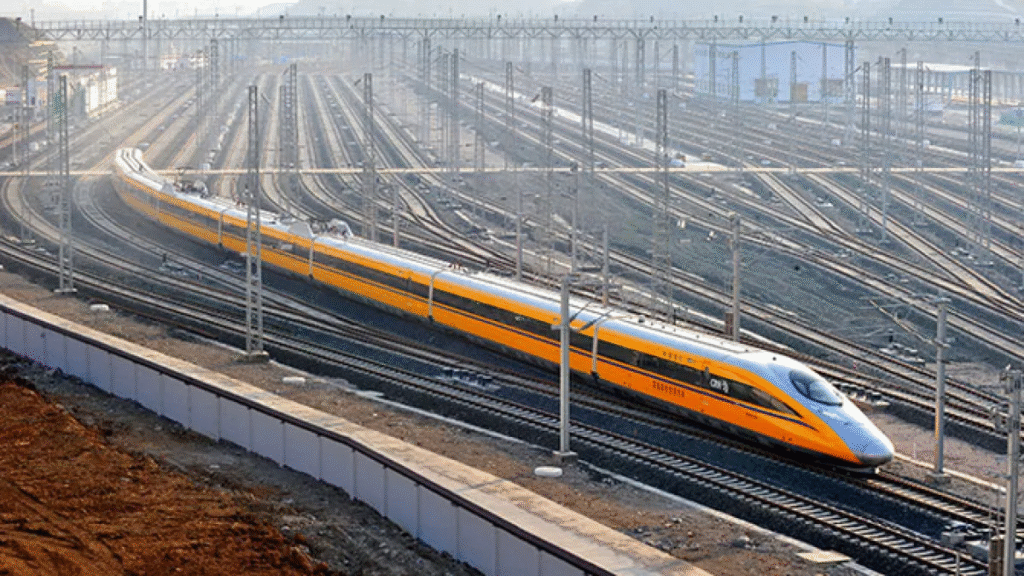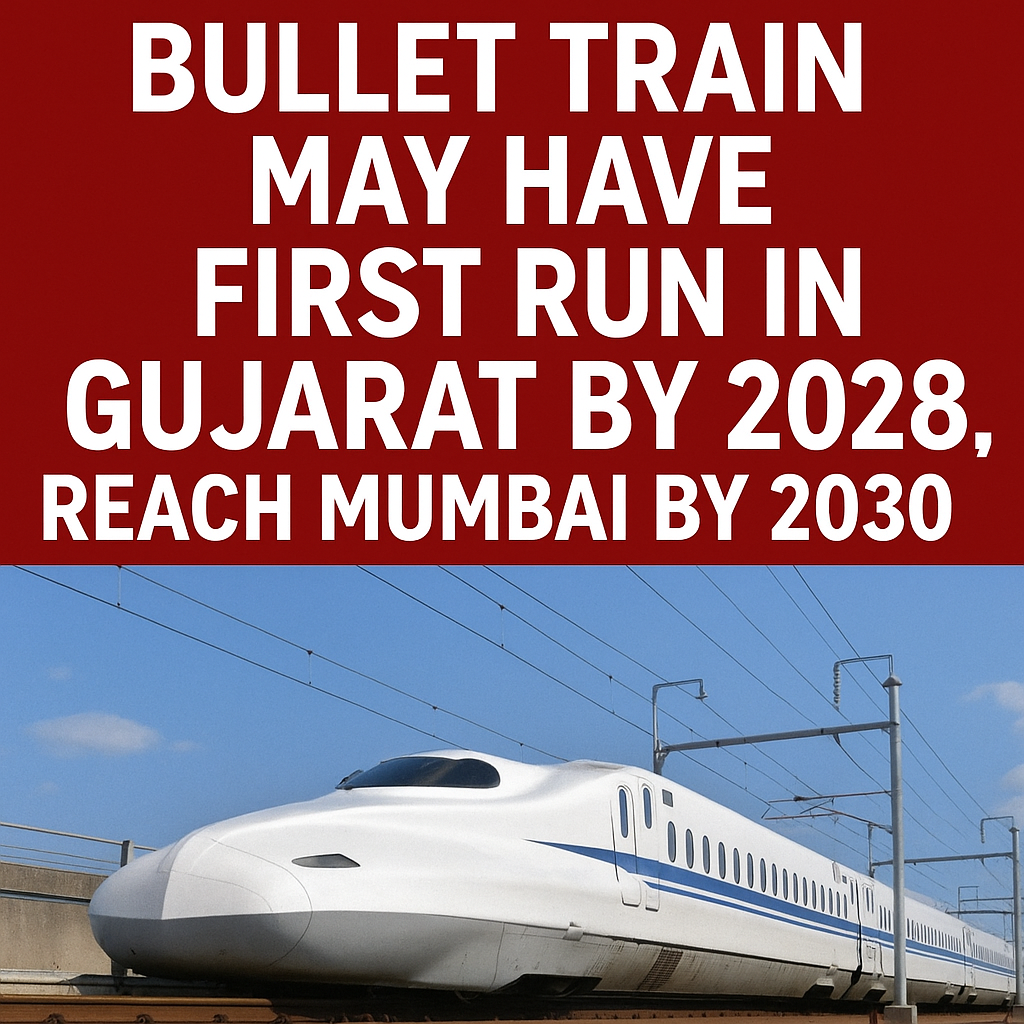
The Indian transportation landscape is on the brink of a monumental transformation. The ambitious bullet train project, connecting Ahmedabad in Gujarat to Mumbai in Maharashtra, is making steady progress with a proposed partial operational launch by 2028. According to reports, the project is expected to fully connect the two major cities by 2030. This development signals a new era of high-speed rail travel in India, blending cutting-edge technology with economic growth.
The bullet train project, formally known as the Mumbai-Ahmedabad High-Speed Rail (MAHSR) project, is a collaboration between the Government of India and the Japanese Government, with the latter providing significant technical and financial assistance. The project’s success will not only boost the nation’s infrastructure but also set a benchmark for future high-speed rail systems in India. This ambitious initiative is designed to reduce travel time, promote regional economic integration, and improve connectivity.
High-Speed Rail: A Game-Changer for India
The bullet train project represents a pivotal moment for India’s transportation infrastructure. This state-of-the-art train will operate at a speed of approximately 320 km/h, drastically reducing travel time between Ahmedabad and Mumbai from eight hours to just two hours. For a rapidly urbanizing country, this will serve as a significant upgrade, fostering faster and more efficient travel.
This transformation goes beyond speed. The train’s introduction aligns with India’s broader goals of modernization and sustainable development. By adopting energy-efficient electric traction systems, the bullet train will reduce dependency on fossil fuels, thereby minimizing the carbon footprint of intercity travel. Furthermore, the project is designed with passenger comfort in mind, featuring modern amenities such as ergonomic seating, advanced air conditioning, and a quiet, smooth ride.
High-speed rail is also expected to transform the way people perceive travel. Currently, long-distance travel in India is dominated by conventional trains and flights. The bullet train offers a middle ground, combining the comfort and speed of air travel with the affordability and accessibility of rail transport. This shift could redefine travel habits, making high-speed rail a preferred mode for both business and leisure travelers.
Gujarat Takes the Lead in India’s Bullet Train Vision
Gujarat’s strategic role in the bullet train project is evident. With over 350 kilometers of the 508-kilometer route traversing through Gujarat, the state is at the heart of this ambitious endeavor. Reports suggest that the first operational segment of the bullet train will run exclusively within Gujarat by 2028, showcasing the state’s commitment to infrastructure development.
The Gujarat government has left no stone unturned in ensuring the project’s timely progress. Land acquisition, a major hurdle in infrastructure projects, has been significantly streamlined. With over 90% of the required land already acquired, the state has demonstrated remarkable efficiency. Key stations in cities like Surat and Vadodara are being developed with world-class facilities to complement the futuristic vision of the bullet train.
Moreover, the project promises a significant economic boost for Gujarat. From generating employment during the construction phase to creating opportunities in ancillary industries, the bullet train’s impact will ripple across the state’s economy. Enhanced connectivity is expected to stimulate tourism and trade, further solidifying Gujarat’s position as a leading economic hub.
Gujarat’s involvement in this project also underscores the state’s commitment to innovation and technology adoption. The construction of state-of-the-art stations, implementation of advanced signaling systems, and integration of environmentally friendly practices are all part of Gujarat’s strategy to set new standards in infrastructure development.
Mumbai’s Role and the Road Ahead
While Gujarat will be the first to experience the bullet train’s benefits, the ultimate goal is to connect Ahmedabad and Mumbai seamlessly by 2030. Mumbai, India’s financial capital, stands to gain immensely from the high-speed rail link. Improved connectivity will facilitate the movement of professionals, foster business exchanges, and attract global investments.
However, the journey to 2030 is not without challenges. Land acquisition issues persist in certain pockets of Maharashtra, and the project’s timeline depends heavily on resolving these roadblocks. Additionally, the construction of critical infrastructure, including bridges, tunnels, and stations, requires meticulous planning and execution. Despite these challenges, the project remains on track, thanks to the concerted efforts of various stakeholders.
Mumbai’s role as a financial and cultural hub further highlights the importance of the bullet train. Enhanced connectivity will not only ease travel but also strengthen the city’s position as a global destination for business and tourism. The bullet train is expected to boost Mumbai’s economy by creating new opportunities in real estate, retail, and hospitality.
Technological Marvels of the Bullet Train
One of the most fascinating aspects of the bullet train project is its reliance on cutting-edge Japanese technology. The Shinkansen E5 series trains, renowned for their speed, safety, and efficiency, will form the backbone of this high-speed rail system. These trains are equipped with advanced safety features, including automatic train control systems and earthquake-resistant designs, ensuring passenger safety even in adverse conditions.
Furthermore, the project includes the construction of India’s first undersea rail tunnel. This 21-kilometer stretch near Thane will not only be an engineering marvel but also a significant milestone in India’s infrastructure history. The tunnel’s construction involves advanced techniques such as tunnel boring machines (TBMs) and specialized waterproofing measures to withstand underwater pressures.
Another notable feature of the project is the integration of green technologies. Solar panels, rainwater harvesting systems, and energy-efficient designs are being incorporated into station buildings and rail infrastructure. These initiatives align with India’s commitment to sustainability and its goal of achieving net-zero carbon emissions by 2070.
Economic and Social Impact

The bullet train project is poised to have a profound economic and social impact on India. The direct benefits include reduced travel time, increased efficiency, and enhanced passenger convenience. Indirectly, the project will stimulate economic growth by creating jobs, boosting tourism, and attracting investments.
From a social perspective, the bullet train represents a symbol of India’s progress. It underscores the country’s commitment to adopting global best practices and implementing world-class infrastructure projects. The project also highlights India’s capacity to balance development with sustainability, showcasing an eco-friendly alternative to conventional travel modes.
Employment generation is another significant aspect of the project. The construction and operational phases are expected to create thousands of jobs, ranging from skilled labor to technical experts. Additionally, the project will spur the growth of ancillary industries such as manufacturing, logistics, and hospitality, contributing to overall economic development.
Enhancing Regional Connectivity
The bullet train’s impact extends beyond Ahmedabad and Mumbai. The intermediate stations, including Surat, Vadodara, and Thane, will benefit from improved connectivity, fostering regional economic integration. These cities are expected to witness increased investments, better access to markets, and enhanced quality of life for residents.
Surat, for instance, is a major hub for textiles and diamonds. The bullet train will provide faster and more efficient access to national and international markets, boosting the city’s economic prospects. Similarly, Vadodara’s industrial landscape will gain from improved connectivity, attracting businesses and fostering innovation.
The project also has the potential to bridge urban-rural divides. By improving access to remote areas, the bullet train will enable better opportunities for rural communities, reducing disparities and promoting inclusive growth.
Global Implications and India’s Aspirations
India’s foray into high-speed rail has far-reaching implications. It positions the country as a global player in advanced transportation systems and reflects its ambition to match international standards. The bullet train project also strengthens bilateral ties with Japan, paving the way for future collaborations in technology and infrastructure.
As India embarks on this transformative journey, the bullet train is more than just a mode of transport; it is a statement of intent. It signifies the country’s readiness to embrace innovation and compete on the global stage. The project’s success will likely inspire similar initiatives across India, creating a robust network of high-speed railways.
Furthermore, the project has garnered international attention, showcasing India’s ability to execute large-scale infrastructure projects. It sets a precedent for future collaborations with global partners, enhancing India’s reputation as a reliable investment destination.
Challenges and Mitigation Strategies
Despite its potential, the bullet train project faces several challenges. Land acquisition remains a contentious issue, particularly in urban areas where land is scarce and expensive. To address this, authorities have adopted a transparent and inclusive approach, engaging with stakeholders to resolve disputes amicably.
Financing is another critical challenge. While Japan has provided a low-interest loan covering a significant portion of the project cost, managing financial resources effectively is crucial to ensure timely completion. The government is exploring innovative financing models, including public-private partnerships (PPPs), to bridge funding gaps.
Technical challenges, such as constructing undersea tunnels and managing high-speed operations in India’s diverse climatic conditions, require meticulous planning and expertise. Collaboration with Japanese experts and the adoption of advanced technologies are expected to mitigate these risks.
Conclusion: A Vision for the Future
The Mumbai-Ahmedabad bullet train project is a landmark initiative that promises to redefine India’s transportation landscape. As the project progresses toward its 2028 and 2030 milestones, it carries the hopes and aspirations of a nation eager to propel itself into the future. While challenges remain, the combined efforts of the government, industry, and international partners ensure a bright future for India’s high-speed rail ambitions.
With Gujarat leading the way and Mumbai poised to benefit immensely, the bullet train project is more than just an infrastructure venture; it is a catalyst for economic growth, technological advancement, and national pride. As India races toward 2028, the bullet train stands as a testament to the country’s resilience, innovation, and determination to build a better tomorrow.
Looking ahead, the success of the bullet train project will likely inspire similar initiatives across the country, paving the way for a new era of high-speed rail travel in India. This transformative journey underscores the importance of collaboration, innovation, and perseverance in achieving ambitious goals. As India moves closer to realizing its high-speed rail dream, the bullet train project remains a beacon of progress, symbolizing the nation’s relentless pursuit of excellence.

